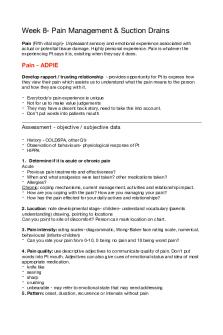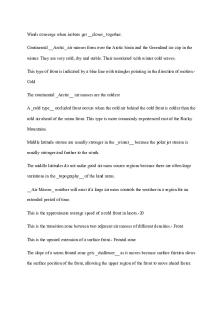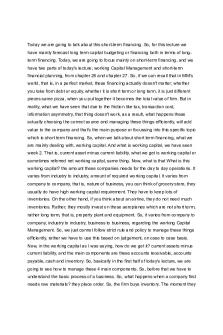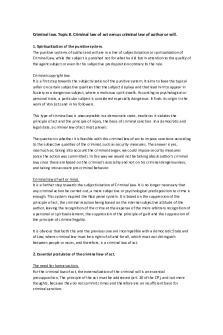Lecture 8 - n/a PDF

| Title | Lecture 8 - n/a |
|---|---|
| Course | Accounting Systems Design and Development |
| Institution | Macquarie University |
| Pages | 5 |
| File Size | 135.8 KB |
| File Type | |
| Total Downloads | 59 |
| Total Views | 160 |
Summary
n/a...
Description
Lecture 8General Ledger and financial reporting The general ledger and financial reporting cycle summarises, adjusts and reports on data from all the previous operational cycles. Key objectives and strategic implications of the general ledger and financial reporting cycle The first part of the financial reporting and general ledger cycle involves creating budgets for the upcoming period, then extracting transactional data generated by the operational cycles. A summarised version of these transaction streams is transferred into the relevant general ledger accounts to create a trial balance. Once a bank reconciliation has been successfully completed, adjusting journal entries are prepared and input to create an adjusted trial balance. After the adjusted trial balance has been finalised, reporting can take place. The objective of the general ledger and financial reporting cycle is to synthesise and report data that accurately represent business transactions and activities. To achieve this, budgets must be accurate, and all transactions extracted and posted must be complete and accurate. The strategic implications of the general ledger and financial reporting cycle revolve around two main areas. 1. The need for good decision making within the organisation. Poor reports lead to poor decision making, which can lead to eventual business failure; high-quality decision making requires good data and comprehensive reports. 2. The strategic implications of producing external reports are equally serious. As external reports are widely distributed, any errors in financial reporting can lead to serious corporate problems. Common technologies underpinning the general ledger and financial reporting cycle A range of data management tools are available to help improve the ability to transfer, analyse and report financial data within the general ledger and financial reporting cycle, including enterprise resource planning (ERP) systems, which integrate the general ledger with the operational cycles that precede it and facilitate stronger controls over the extraction and posting of data from the subsidiary ledgers. Access to online banking is helpful when preparing bank reconciliations, improving the timeliness and accuracy of this important reconciliation. Business intelligence tools can support interrogation of the underlying data and data dictionary, and the creation of reports. eXtensible Business reporting language (XBRL) allows semantics, or meaning, to be embedded within strings of financial data, allowing more in-depth analysis to be conducted by users and recipients of financial data.
General ledger and financial reporting cycle data and key general ledger and financial business decisions
Process business decisions are made from several different perspectives during the general ledger and financial reporting cycle. Budget-related decisions include what level to budget at, how far to break budget amounts down to and how high (or low) to set budget targets. Typical budget decisions include: budget level- budgets can be set at a range of levels. Many organisations budget down to a level known as ‘line item’ where budgets are set for each different type of revenue and expense for each division as contained in the chart of accounts budget breakdown- budgets can be established with an annual tool, or they can be broken down into months. The degree of granularity at which the budget is set determines how useful the budget targets will be during performance monitoring budget targets- setting budget targets require balance between what is desired in terms of performance and what is thought to be possible. Decisions relating to general journal entries would include consideration of accounting standards, accounting policies and procedures, timing differences and the need to incorporate data from external sources such as bank statements. In addition to these journals adjustment decision, the reports produced by this cycle are used to inform decision makers within the organisation. Common examples of such reports include: Profitability analysis for the organisation or a division Analysis of performance for an individual or a division Analysis of profitability potential to guide future investment decisions Cost management analysis for decision making Primary activities in the general ledger and financial reporting cycle and the data produced by these activities Contextually, the general ledger and financial reporting cycle involves direct interaction with entities outside the organisation that use the general purpose financial statements produced, and with the bank to obtain details of bank account transactions. Within the organisation, the general ledger and financial reporting cycle interacts with the production, HR management and payroll, expenditure and revenue cycles, along with managers of operational departments, initially to create budgets and later when conducting variance analysis relating to operational performance. Primary activities within the cycle include preparing budgets, updating the general accounts, recording general ledger adjustments and producing reports. A range of data types are accessed by activities within the general ledger and financial reporting cycle, including those contained in the accounts payable, accounts receivable, production costs and payroll costs data stores. General ledger data stores are used to provide and store budget data. The general ledger and financial reporting data is used to support decision making within the organisation and to create all external general purpose financial statements.
General ledger and financial reporting cycle activities and related risk and controls Prepare budgets- activities, risks and controls
The general ledger and financial reporting cycle begins with the creation of an operational budget. Budgets are planning estimates of future revenue and expenditure items, and are an important management tool. Activity Conducted by Description Risks encountered Common controls Determine Budget staff, Determine budgets for revenue Under/ Independent approval budget department and expenditure items for the overestimating of budget estimates. vales managers following period. This may be revenue and Presentation of calculated by referencing historical expenditure estimates by transactions and indexing by some operational managers estimated percentage amount, or Aggregation of by analysing proposed activity department budget levels for the future period and totals and independent then calculating estimated revenue approval of overall and expenditure based on budget totals predicted activity levels. Tight linkages between budget values and performance monitoring systems Data entry errors Edit checks on input The approved budget totals input Budget Record Reasonability checks officer/various into the central computer to budget Using batch totals establish the budget levels for departments details Independent approval future periods of final budget inputs Activity
Conducted by
Description
Risks encountered Incomplete data
Extract and validate data
Computer
Once processing in the subsidiary ledgers has been successfully completed, the revenue, expenditure, production, and HR management and payroll cycles send a notification to the financial cycle. The summarised details from all subsidiary transaction systems Inaccurate data created by these other cycles are then able to be extracted for posting into the general ledger
Post transaction
Computer
Inaccurate The verified summarised transaction data are posted to the updating relevant general ledger accounts. Once transactions have been successfully posted to the relevant accounts the transactions contained in the subsidiary ledger data stores are
Common controls Batch totals and hash totals Using ledger control accounts that detail totals posted from each ledger and allow comparison of those totals Automated system exception reports that identify any problems encountered during extraction and validation Batch totals and hash totals Regular control account reconciliations
updated with a status code to indicate that they have been posted to the general ledger accounts Record general ledger adjustments- activities, risks and controls Activity conducted by Description Risks encountered Errors in journal A bank reconciliation is Accounting Prepare entries completed and general journal adjustment staff entries are prepared for any journals accounting adjustments required. These adjustments typically recognise end-of-period accruals and capture transactions such as bank fees or interest charges not captured by the transaction processing systems
Post adjustment journals
Accounting staff
Activity
conducted by
The approved journals are posted Data entry errors to the relevant general ledger accounts
Description
accounting/staff Reports are created based on a Produce report specification template management department staff/computer that outlines the column reports headings, totals required and layout for the required report. This report template is then populated with the transaction data that fits the requested report parameters
Risks encountered Incorrect report parameters/ incorrect data reported
Unauthorised distribution of financial data
Common controls Independent approval of journal entries by senior accounting staff Attaching full working papers to support journal entry calculations Documenting any assumptions and algorithms relied on when calculating journal amounts Mandating the provision of source documents where available Batch totals (to ensure correct amounts entered) and hash totals (to ensure correct general ledger accounts selected) One-for-one checking of general journal entry inputs Common controls Limiting report generation functionality to appropriately trained staff Requiring independent authorisation for any new report Secure privacy settings on electronic reports limiting ability to print/redistribute reported data Secure document
Produce financial statements
Accounting staff/computer
General purpose financial statements are produced at predetermined intervals and are constructed in accordance with relevant accounting standards Accounting standards are used to create the business rules and specifications underlying the financial data report parameters.
Incorrect data reported
management for reports containing sensitive data Security profiles allowing read-only access to financial data maintained at an individual staff member level Oversight by senior accounting staff and internal audit Regular checks for compliance with accounting standards and policies.
Metrics to monitor general ledger and financial reporting cycle performance Process performance should be measured relative to the desired outcomes of the process. To monitor process performance, a wide range of metrics needs to be employed along with some realistic targets Examples include Variance analysis The number of data errors detected Evidence of reconciled balances in subsidiary ledger control accounts The number of uncleared transactions in suspense accounts The level of unadjusted balances in asset and liability accounts Success in reporting could be measured by the degree of compliance with accounting policies, the number of complaints received from report users and the number of data errors identified in reports....
Similar Free PDFs

8 - Lecture notes 8
- 21 Pages

8 - Lecture notes 8
- 21 Pages

Lecture 8 - 8 lec
- 6 Pages

Lecture 8
- 1 Pages

Lecture 8
- 5 Pages

Lecture 8
- 3 Pages

Lecture 8
- 2 Pages

8 Midwifery - Lecture notes 8
- 3 Pages

Taxation 8 - Lecture notes 8
- 2 Pages

Week 8 - Lecture notes 8
- 6 Pages

CH 8/ Lecture 8 ANSWERS
- 13 Pages

Dox 8 - Lecture notes 8
- 21 Pages

Lesson 8 - Lecture notes 8
- 2 Pages

Assignment 8 - Lecture notes 8
- 4 Pages

Othello playlist - NA/NA
- 2 Pages
Popular Institutions
- Tinajero National High School - Annex
- Politeknik Caltex Riau
- Yokohama City University
- SGT University
- University of Al-Qadisiyah
- Divine Word College of Vigan
- Techniek College Rotterdam
- Universidade de Santiago
- Universiti Teknologi MARA Cawangan Johor Kampus Pasir Gudang
- Poltekkes Kemenkes Yogyakarta
- Baguio City National High School
- Colegio san marcos
- preparatoria uno
- Centro de Bachillerato Tecnológico Industrial y de Servicios No. 107
- Dalian Maritime University
- Quang Trung Secondary School
- Colegio Tecnológico en Informática
- Corporación Regional de Educación Superior
- Grupo CEDVA
- Dar Al Uloom University
- Centro de Estudios Preuniversitarios de la Universidad Nacional de Ingeniería
- 上智大学
- Aakash International School, Nuna Majara
- San Felipe Neri Catholic School
- Kang Chiao International School - New Taipei City
- Misamis Occidental National High School
- Institución Educativa Escuela Normal Juan Ladrilleros
- Kolehiyo ng Pantukan
- Batanes State College
- Instituto Continental
- Sekolah Menengah Kejuruan Kesehatan Kaltara (Tarakan)
- Colegio de La Inmaculada Concepcion - Cebu
